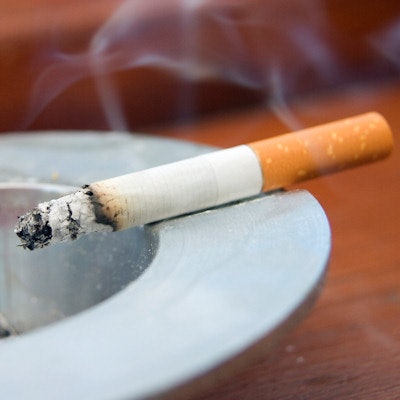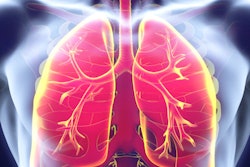
For U.S. Veterans Affairs (VA) patients at high risk for lung cancer, CT screening is a "complex endeavor" that turns up multiple comorbidities and introduces potential harms and increased costs, concludes a new study published online January 30 in JAMA Internal Medicine.
Investigators from eight VA centers across the U.S. screened more than 2,000 patients over two years using criteria from the National Lung Screening Trial (NLST), but with a cohort that trended older and tended to have smoked more. They found nodules in 57% of all screening subjects -- more than twice the initial positive rate of NLST -- as well as significant comorbidities in the sickest patients.
"The amount of coordination needed between the healthcare system and patients was quite significant," lead author Dr. Linda Kinsinger told AuntMinnie.com. "It took lots of time and effort to provide the service and keep everybody on track."
Relatively few of the patients had early-stage cancers. And although it's too soon to make final conclusions about the efficacy of lung cancer screening in this population, screening is probably not worth the risk and expense in patients who are frail or who have smoking histories shorter than 30 pack-years, Kinsinger said.
Persistent clinical questions
The results of the NLST, which found a mortality reduction of at least 20% in smokers with 30 pack-years or more of smoking history, led to the 2013 recommendation by the U.S. Preventive Services Task Force (USPSTF) to screen smokers and former smokers. There are questions, though, about how well the strong trial results will translate to clinical practice, and screening experience in the clinical setting remains limited.
The VA system cares for some 6.7 million mostly older male veterans each year, many of whom have long smoking histories. Implementing lung cancer screening for them would potentially require significant resources and effort. This study, a three-year lung cancer screening demonstration project, sought to better understand the size of the VA screening population and the clinical implications of implementing lung cancer screening in this population.
The researchers identified 4,246 patients ages 55 to 80 years who met the NLST lung cancer screening criteria, of which about half (2,028 men and 78 women; mean age, 64.9 years) agreed to undergo low-dose screening with CT between July 2013 and June 2015. Patients were excluded if they had a history of esophageal, liver, or pancreatic cancer and a life expectancy of less than six months. Nurses also reviewed patients' smoking histories to identify individuals with at least 30 pack-years of smoking history and exclude those who had quit more than 15 years earlier (JAMA Intern Med, January 30, 2017).
Each of the eight sites named a physician leader (six pulmonologists, one medical oncologist, and one radiologist), and each site also employed a full-time lung cancer screening coordinator, all of whom were midlevel healthcare professionals.
The patient care coordinators were responsible for identifying the right candidates for screening, delivering patient education, and participating in the shared decision-making visit required by the U.S. Centers for Medicare and Medicaid Services (CMS). They scheduled the scans and notified patients about results and follow-up care requirements in coordination with the lead physicians. They also worked with staff, the lead physicians, and steering committee members to develop and modify the implementation guide for each site and revise the electronic tools and database several times, according to Kinsinger.
More nodules, but no more lung cancers
Among the 2,106 patients screened, a total of 1,257 (59.7%) had nodules, of which 1,184 (56.2%) required tracking. Forty-two patients (2%) required further evaluation that didn't lead to a lung cancer diagnosis, while 31 (1.5%) had lung cancer, the authors wrote.
The reason for the high rate of positive results (59.7% versus 27.3% for NLST) "is not certain but may be owing, in part, to the older age and heavier smoking history of veterans screened," the team wrote.
There was also a wide range of nodular findings among the eight sites -- from 30.7% to 85% -- which may reflect, in part, the different geographical locations or differences in interpretation by the participating radiologists, according to the researchers. In all, more than half of the nodules (710/1,293, 54.9%) were 5 mm or smaller, and 83% were solid.
Nearly all of the positive results were negative for cancer, producing a false-positive rate of 97.5%. Twenty (64.5%) of the 31 cancers were stage I. The average time from screening to lung cancer diagnosis was 137 days.
Tough job, uncertain benefit
Radiologists and coordinators recorded only incidental findings that were likely to include follow-up or additional evaluation. In all, 40.7% (857) of patients had one or more reported incidental findings. The most common were emphysema, other pulmonary abnormalities, and coronary artery calcifications.
The demonstration project showed that developing and implementing a comprehensive lung cancer screening program "is a complex and challenging undertaking, and that most patients will have findings that require follow-up; however, few patients will have early-stage lung cancers," the authors wrote. As a result, implementing a comprehensive lung cancer screening program "requires significant clinical effort for as-yet-uncertain patient benefit."
For example, the project required the development of an array of new tools and patient care processes to capture the necessary real-time clinical data that met the needs of the care coordinators. Better information about smoking history and pack-years is needed, and it is currently not fully captured in the electronic medical record, according to the group.
"It was much more than I expected in terms of the effort that was required and all of the implications we learned about," Kinsinger told AuntMinnie.com. "Coordination between the healthcare system and the patient was also quite significant. It took lots of time and effort to provide the service and keep everybody on track, and the level of coordination and collaboration that was required for the various clinical services -- including primary care, pulmonary, radiology, and, for a few patients, surgery -- was significant."
The screening coordinators were absolutely essential in holding it all together, Kinsinger said.
"They were often the ones who trained the primary care staff in terms of how to identify appropriate patients for screening and, in some cases, participated in the shared decision-making meeting with patients," she said.
And it often fell to patient coordinators to explain the complicated balance of potential benefits and harms of screening, as well as the fact that patients could have a positive finding that would probably not turn out to be cancer, Kinsinger said.
Is screening worth it?
Given the difficulties of lung cancer screening in this population, is the benefit worth the effort? For most patients it probably is, "but I think it will take more time to really know," she said. "Very frail patients and those with limited life expectancies should not be offered screening, and the highest-risk patients and heaviest smokers will likely have the greatest benefit."
Kinsinger said she also worries a bit about the indications and the participation by patients who are younger and have less of a smoking history.
"I think the likelihood of benefit is very small but the potential for harm is still there if we start screening lower-risk patients," she said.
Despite the reduced cost-benefit ratio, the trend to encourage screening of those lower-risk patients is real, she added.




















